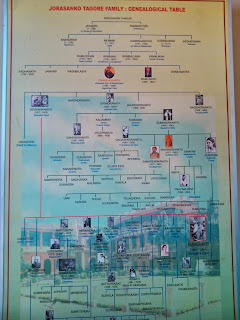Exhibition Of Musical Instruments At Indian Museum In Kolkata
Once upon a time, musical instruments used to export in Japan through
China and Korea. Again, a few
instruments came from Iran and Afghanistan. As a result, Indian
heritage of musical instruments enriched. Many music lovers of Bengal
stepped forward to preserve musical instruments. Raja of Pathuriaghata
- Sir Sourindra Mohan Thakur was one of them. In the year 1875,
Sourindra Mohan, Jatindra Mohan and Rani Swarnamoyee gifted several
musical instruments to Kolkata Museum. Amongst them, a few instruments
of 'Bengali Band' played at the reception of 7th Edward, came to
Kolkata as Prince Of Wales. We came to know from the book 'Universal
History Of Music' (1896) by Sourindra Mohan that in the year 1878, at
the time of his Japan tour, the then Emperor Mikado gifted him various
musical instruments like flute, organ, harp, veena and drums of
different sizes. The big drum was painted by traditional Japanese
paintings and in the name of famous ancient warrior 'Taiko'. A gallery
of Indian Museum was formed by these musical instruments. In the year
1914, before the centenary of Indian Museum, he gifted these historic
instruments in the list of 'Magnificent Series Of Japanese and Bengali
Musical Instruments'. But it is sad, he died in June of that year. His
son Kumar Shyam Kumar Thakur gifted the museum an oil painting of his
father portrait by Italian painter Fereti. An exhibition of 40 (out of
90) musical instruments gifted by the Raja, is now opened at Indian
Museum in Kolkata for all from 18-25 May 2011 (11am-5pm).
--
A. B.
China and Korea. Again, a few
instruments came from Iran and Afghanistan. As a result, Indian
heritage of musical instruments enriched. Many music lovers of Bengal
stepped forward to preserve musical instruments. Raja of Pathuriaghata
- Sir Sourindra Mohan Thakur was one of them. In the year 1875,
Sourindra Mohan, Jatindra Mohan and Rani Swarnamoyee gifted several
musical instruments to Kolkata Museum. Amongst them, a few instruments
of 'Bengali Band' played at the reception of 7th Edward, came to
Kolkata as Prince Of Wales. We came to know from the book 'Universal
History Of Music' (1896) by Sourindra Mohan that in the year 1878, at
the time of his Japan tour, the then Emperor Mikado gifted him various
musical instruments like flute, organ, harp, veena and drums of
different sizes. The big drum was painted by traditional Japanese
paintings and in the name of famous ancient warrior 'Taiko'. A gallery
of Indian Museum was formed by these musical instruments. In the year
1914, before the centenary of Indian Museum, he gifted these historic
instruments in the list of 'Magnificent Series Of Japanese and Bengali
Musical Instruments'. But it is sad, he died in June of that year. His
son Kumar Shyam Kumar Thakur gifted the museum an oil painting of his
father portrait by Italian painter Fereti. An exhibition of 40 (out of
90) musical instruments gifted by the Raja, is now opened at Indian
Museum in Kolkata for all from 18-25 May 2011 (11am-5pm).
--
A. B.



Comments